
Nałęcz is a Polish coat of arms. It was used by associated szlachta families in the Kingdom of Poland and the Polish–Lithuanian Commonwealth (1569–1795).
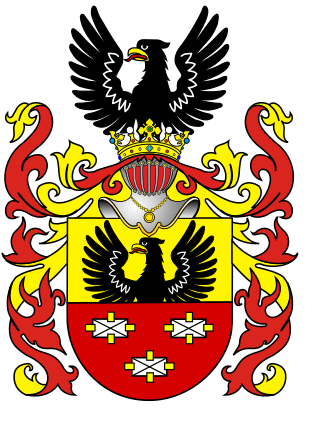
Sulima is a Polish coat of arms. It was used by several szlachta families in the Kingdom of Poland and the Polish–Lithuanian Commonwealth. Notable people using the symbol were Zawisza Czarny—a famous Polish knight—and the Sułkowski family.
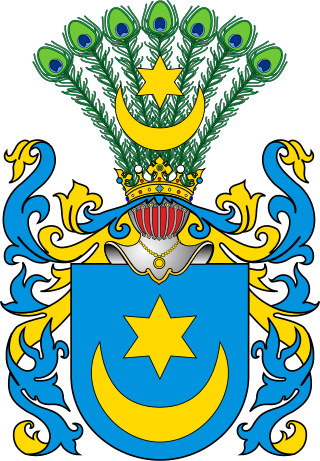
Leliwa is a Polish coat of arms. It was used by several hundred szlachta families during the existence of the Kingdom of Poland and the Polish–Lithuanian Commonwealth, and remains in use today by many of the descendants of these families. There are several forms of the arms, all of which bear the name, Leliwa, but which may be distinguished as variations of the same arms by the addition of a Roman numeral. In 19th century during a pan South-Slavic Illyrian movement heraldic term Leliwa also entered Croatian heraldry as a name for the coat of arms considered to be the oldest known symbol; Bleu celeste, a mullet of six points Or surmounted above a crescent Argent – A golden six-pointed star over a silver crescent moon on a blue shield, but also as a name for all other coats of arms that have a crescent and a mullet.
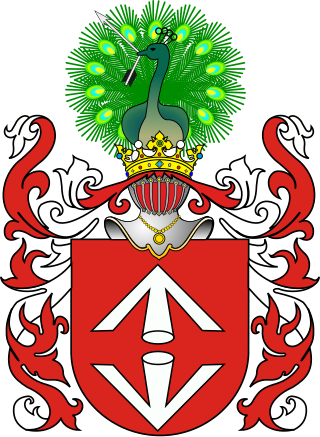
Bogoria is a Polish coat of arms. It was used by several szlachta families in medieval Poland and later under the Polish–Lithuanian Commonwealth, branches of the original medieval Bogoriowie family as well as families connected with the Clan by adoption.

Pierzchała (Roch) is a Polish coat of arms. It was used by several szlachta families in the times of the Kingdom of Poland and the Polish–Lithuanian Commonwealth.
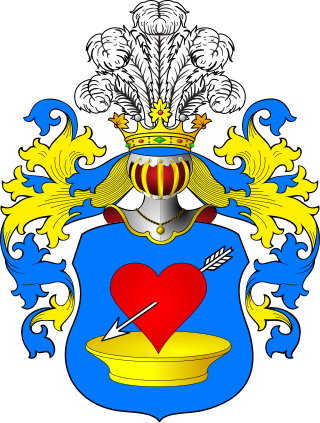
Przyjaciel also known as "de Pryjatel" and "Amicus" is a Polish coat of arms. It was used by several szlachta (noble) families under the Kingdom of Poland and the Polish–Lithuanian Commonwealth.

Alabanda is a Polish nobility coat of arms, used by several szlachta families in the times of the Kingdom of Poland.

Wieniawa is a Polish coat of arms. It was used by several noble, in Polish language szlachta families in the times of medieval Poland and the Polish–Lithuanian Commonwealth.

Hozyusz is a Polish coat of arms. It was used by several szlachta families.

Późniak or Przestrzał is a Polish coat of arms.

Bes(Bies, Bees, Beess) is a Polish coat of arms.

Cieleski is a Polish coat of arms. It was used by several szlachta families in the times of the Polish–Lithuanian Commonwealth. A variation of the Trestka coat of arms.

Ryc is a Polish coat of arms. It was used by the Ryc and Rydz szlachta families.

Oszyk is a Polish coat of arms. It was used by the Sienkiewicz family.

Pogonia is a Lithuanian and Polish coat of arms. It was used by several szlachta families in the times of the medieval Poland and the Polish–Lithuanian Commonwealth.

Sandrecki is a Polish coat of arms. It was used by the Sandrecki szlachta family.

Chyliński is a Polish coat of arms. It was used by several szlachta families.

Bieńkowski is a Polish coat of arms. It was used by one szlachta family in the times of the Polish–Lithuanian Commonwealth.
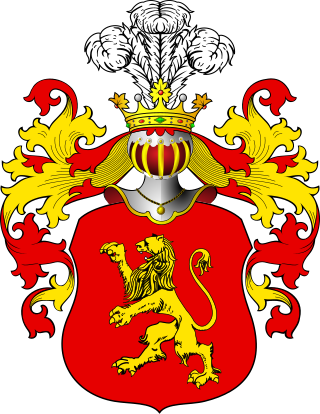
Lew II - Polish coat of arms, used by several genera. Two of them were families from the region of Kaszuby. Coat of arms "Lew II" is a variant of the coat of arms "Leo".

The Scibor-Bogusławski family – a Polish noble family with the coat of arms of Ostoja, belonging to the heraldic Clan Ostoje (Moscics), originating from Bogusławice in the former Sieradz Province, Radomsko County.




















